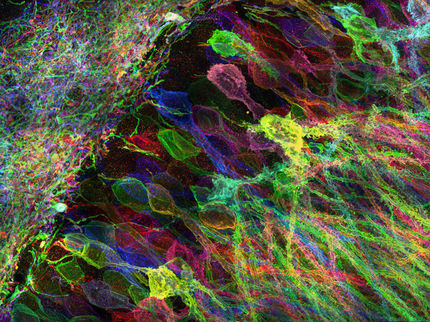MicroRNA comprehensively analyzed
Messenger RNA transmits genetic information to the proteins, and microRNA plays a key role in the regulation of gene expression. Scientists from the Moscow Institute of Physics and Technology and the Research Centre for Medical Genetics have described the complex interactions between these two and other kinds of human RNA. The paper was published in Frontiers in Genetics.

Messenger RNA transmits genetic information to the proteins, and microRNA plays a key role in the regulation of gene expression. Scientists from the Moscow Institute of Physics and Technology and the Research Centre for Medical Genetics have described the complex interactions between these two and other kinds of human RNA.
@tsarcyanide/MIPT Press Office
What are microRNA and Argonaute proteins?
Ribonucleic acid, or RNA, is an essential molecule encoding genetic information in cells. Its three main types are called transfer, ribosomal, and messenger RNA. The latter is also known as mRNA and serves as an intermediary between DNA -- the gene repository -- and the protein molecules resulting from gene expression. mRNA is synthesized in the nucleus based on the DNA sequence. It is then transported out into the cytoplasm, where it becomes a template for protein synthesis. However, only about 2% of the RNA molecules produced by a cell serve as protein templates. Among the remaining ones is the so-called microRNA, which is 18 to 25 nucleotides long and plays an entirely different role.
MicroRNAs are a group comprising about 2,500 molecules known for human so far, which bind with proteins from the Argonaute family (AGO) and function together. The small-sized microRNA-AGO complex binds to particular mRNA sites, and it is always the microRNA component of the complex that determines which region of which mRNA to bind to. The Argonaute protein either blocks protein production from mRNA or eliminates the mRNA by "cleaving" it. Therefore, if a microRNA-AGO complex engages with a certain mRNA, its corresponding protein will no longer be produced. That way genes are effectively silenced by microRNA "capturing" mRNA and affecting gene expression.
While the interaction occurs between microRNA and mRNA, it is often seen as that between microRNA and the gene encoding the mRNA. This silencing is one of the numerous mechanisms for regulating gene expression. Cells employ them to control gene productivity by enabling or disabling genes to a varying degree. Misregulation of gene expression due to microRNA "malfunctions" can cause cancer and other pathologies.
Geneticists still do not fully understand the interactions between the two types of RNA. There are about 20,000 known human mRNAs and 2,500 microRNAs, but it remains unclear which of them actually bind to each other. The researchers previously showed that the computer programs predicting interactions between microRNA and mRNA do not work properly.
In their new research, the scientists combined the experimental data on the amount of mRNA and microRNA formed in a cell with the data on the interactions between these two kinds of RNA for two types of human cells. The team explored the connection between the amount of a microRNA in a cell and it's binding activity. One would expect the two quantities to be in direct proportion to each other, but that proved not to be the case. The researchers also looked at how many pairs an mRNA formed and whether with the same or with different microRNAs. Scientifically speaking, the geneticists explored the relation between the expression level and the binding activity for mRNA and microRNA. They also explored the way the behavior of these pairs depends on cell type.
"Our research explores the interaction between microRNA and genes," said Olga Plotnikova, a PhD student at MIPT and one of the authors of the research. "A microRNA is a small noncoding RNA molecule that regulates gene expression. We published an article showing the imperfections of the computer programs used to predict the interactions between microRNA and genes. That's why we wanted to get the full picture of microRNA interactions: what binds with what and how.
"We analyzed the only two available papers on this subject that report the experimental data on the entire range of interactions between microRNA and genes, for two different human cell lines. Then we correlated the data with the results of other experiments, determining the expression level of mRNA and microRNA in the same cell lines," Plotnikova went on. "We showed that microRNA does not strongly regulate all genes and its regulation potential does not directly depend on its expression level. We also identified the differences between the microRNA interactions in the two cell lines."
Methods
The main problem with the empirical research into microRNA interactions has to do with the limitations of the available methods. There is a set of methods known as reporter gene assays, which can test one particular interaction with an experiment. Another set of methods, called cross-linking with immunoprecipitation (CLIP), enables researchers to identify the binding sites, but not the specific microRNAs associated with them. Cross-linking is typically used to determine the position of direct interactions between proteins and nucleic acids. It enables to purify a specific protein-RNA complex so the vast majority of contaminating RNA can be removed. It is thus possible to identify all the microRNA-mRNA binding sites without knowing which of the thousands of known microRNAs was involved in the interaction.
There are two similar techniques that have been recently developed: the CLASH and the CLEAR-CLIP methods. They actually build upon CLIP. The problem with them is that they are very intricate and have only been used on two cancerous human cell lines: kidney cell line and hepatic cell line. The team also used the available data on the amount of mRNA and microRNA formed in each of the cell lines (gene expression data). The scientists used the data obtained in 79 CLIP experiments to identify the mRNA parts interacting with microRNAs. While the experiments establish the existence of these interactions, they do not reveal the exact microRNAs involved.
Research results
The researchers have provided an in silico proof that the data from improved CLIP experiments on the entire range of interactions between microRNA and genes for two different human cell lines are similar and can be compared. It was demonstrated that most mRNA-microRNA complexes are formed by a small number of RNAs. For example, only 1%-2% of protein-encoding genes form more than 10 different interactions. Fascinating kinds of mRNA that exhibit "sponge-like" properties have also been found. Those kinds of mRNA were binding with a large number of RNAs (more than 50) in different mRNA sites. What is more, the researchers found a group of microRNAs with two key features: They are weakly expressed and have a lot of interactions. This runs contrary to the expectation that the more a given microRNA is expressed, the more it should interact with various mRNAs.
The study also established a list of reliable microRNA-binding regions -- the places where mRNA and microRNA interact with each other. This led the team to create online software that determines whether a given position in the human genome coincides with a microRNA binding site. It helps to identify the disruption of microRNA binding and therefore of gene regulation, which means that it can explain genetically inherited diseases. The program could be used for analyzing the genome of patients. Mapping all the interactions between microRNA and human genes helps to reveal the molecular basis of congenital and acquired disorders.




























































